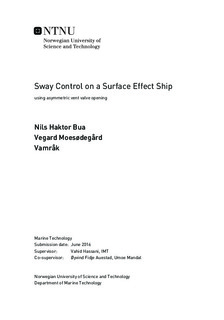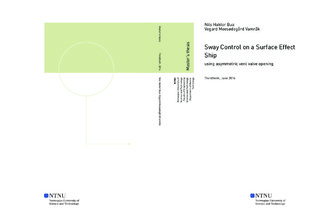| dc.description.abstract | The lateral maneuvering for Surface Effect Ships (SESs) in low velocities is highly limited. Due to SESs hull shape in the bow, it is not an option to use conventional means to get lateral thrust, such as tunnel- or azimuth-thrusters. SESs is a vessel type that uses large amounts of air to achieve several beneficial purposes. A boarding control system (BCS), for vertical bow motion compensation, is already developed. The air is within an air cushion, enclosed by catamaran hulls, a skirt in the bow and a bag in the aft. The needed air pressure in the cushion depends on the conditions and thus varies. It is normal to use inlet fans which runs with constant RPM, and thus delivers a relative constant amount of air. The air pressure is then governed by the vent valves (VVs), i.e. how much air that is let out trough these. On the model that is used in this master thesis, these VVs was moved to the ship sides, above the water surface. If one has a larger air flow through one side than the other, one will produce a net force. The idea with this study is to map the potential of this force. The VVs are placed amidships so they produce sway force, and thus not produce any yaw rotation.
The time usage for the repairs and commissioning was 5-6 weeks. The weeks was used for planning, logistics, repairing damages, making of ducts for placing of the VVs on the ship sides amidships, engineering of VVs with opening/closing mechanism, instrumentation and communication between software (Simulink/Veristand) and relevant sensors and actuators. In addition, the model had to be weighted and tipped to find vertical and horizontal center of gravity.
All of the model testing in this thesis was conducted in the Towing tank III during 3 weeks and followed this general form: 1) Servo and VV test to check the performance of the servos that opens/closes the VVs. 2) Thrust mapping with gradually opening and closing of VVs to find the corresponding force for each opening. The test was performed for both starboard and port side. 3) Sway Control System (SCS) combined with Boarding Control System (BCS) with head sea. SCS was prioritized over BCS. 4) SCS and BCS combined, BCS was prioritized, but with varying degree throughout the wave series with head sea. 5) SCS and BCS combined, BCS was prioritized, but with varying degree throughout the wave series with head quartering sea. 6) Roll motion tests: the eigenperiode for three different vertical center of gravities was measured. Testing the performance of passive roll damping measures like, bilge keels and flaps placed in the aft of the ship. 7) Active roll damping by dividing the air cushion in the longitudinal direction with a flexible wall. The flexible wall produce two air chambers where the air pressure could be controlled individually, and thus induce a roll motion.
Best performance, regarding position error in sway, was observed with SCS in priority. The performance was reduced some when BCS was prioritized over SCS. Although, by reducing the BCS gains the SCS got a more optimal amount of exiting air flow to work with, and the performance was improved dramatically. The optimal working condition for SCS is when the BCS commands half of the total VVs area, i.e. the SCS can direct all exiting air through only one VV. The SCS has throughout the testing period showed promising results, and the recommendation to Umoe Mandal is to implement the SCS on relevant and compatible vessels.
Parts of this master thesis will be presented in a paper, (\textit{Robust Lateral Control of a Surface Effect Ship using} $\mathcal{H}_\infty$ \textit{Mixed Sensitivity Synthesis}), which is approved for the conference: Control Application in Marine Systems (CAMS 2016), in September 2016. During the model testing in the Towing tank III the frequency weighted control law used in the paper was replaced with a PID-controller. The thrust mapping, described in 2) in the section that describes the test regime, was implemented using a second order degree polynomial. The paper is included in appendix \ref{sec:paper}.
Of the passive roll damping measures, it was the bilge that showed the most promising results. The reason for changing the vertical center of gravity was to test the performance of the vessel with potential future designs. | |

